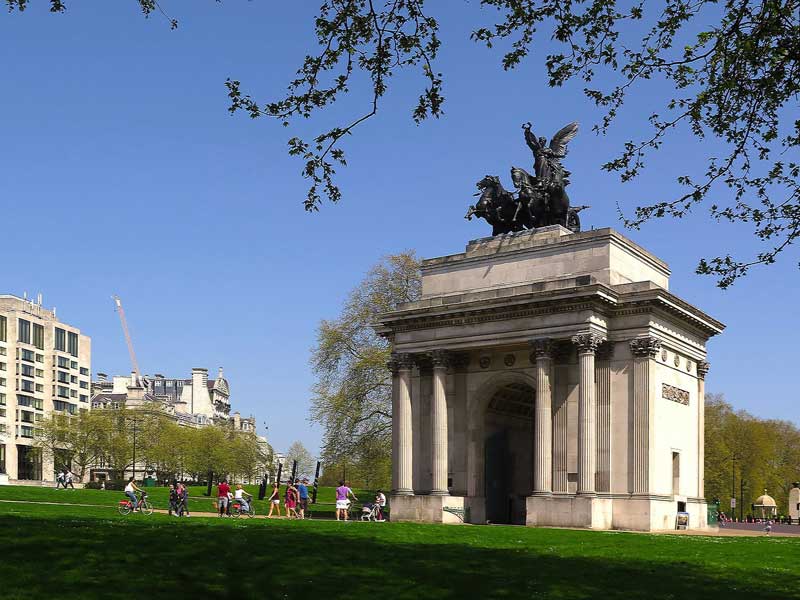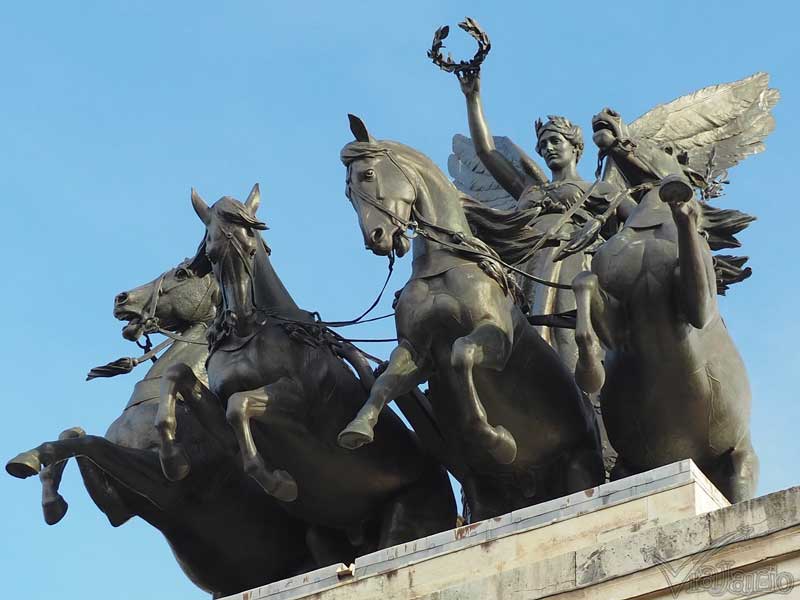
Located in the Royal Heart of London, just south of Hyde Park and set on a large traffic island with crossings for pedestrian access, the Wellington Arch, built between 1825 and 1827, is a magnificent processional arch and one of the iconic landmarks of London. Originally known as the Constitution Arch, it was constructed to serve as an outer entrance to Buckingham Palace and initially stood facing the Hyde Park Screen, only to be moved to its present position in the 1880s and was crowned with the magnificent Quadriga, the four-horse chariot, in 1912.
Unfortunately, the arch was inaugurated without its crowning Quadriga, as originally designed and was left without a crown, until the controversial giant statue of the Duke of Wellington was erected on top of it in 1846 and the arch was renamed after him. But in 1883, the huge and disproportionate equestrian statue was removed from the top of the arch and installed on a new pedestal near the Garrison Church at Aldershot, where it stands today.

In 1824, commissioned by the Office of Woods and Forests, the young architect Decimus Burton produced a design for a relatively modest gateway into Green Park, along with a longer screen entrance to Hyde Park facing the road.
But the design was rejected by an informal government committee, as it considered the proposed Green Park Arch would effectually form an outer entrance to Buckingham Palace and therefore, should be more ornamental and dignified than that of the Façade opposite. Burton, therefore, produced a second design, comprising an explicitly triumphal arch, embellished with ornamental sculptures, complete with a gilded Quadriga, a chariot drawn by four horses, on the top of it and his estimate for the work, excluding the sculpture, was approved by the authority in May 1826.

Although the construction of the arch started in 1826, in the architectural style of the Corinthian Order, featuring elaborate capitals at the top of the columns, the work was suspended in 1828, as the construction costs exceeded Burton’s original budget and at the same time, the rebuilding of Buckingham Palace also put extra pressure on the treasury. As a result, Burton had to scale down his exterior ornamental features, completely eliminating the project of the proposed Quadriga on the top.

After years of standing as a simple arch without a crowning glory, the Wellington Memorial Committee thought it would be appropriate to install an equestrian statue of Arthur Wellesley, the Duke of Wellington atop the arch to commemorate his victory in the Napoleonic Wars. Manipulated by an inner group led by the 5th Duke of Rutland, the committee commissioned their chosen sculptor Rutland’s protégé Matthew Cotes Wyatt for the project and eight years after it was commissioned, the 30 feet tall huge bronze statue of Duke Wellington, weighing 40 tons, was installed on the top the arch in the autumn of 1846. While Britain was incredibly proud of the Duke of Wellington for his victory at Waterloo, his bronze likeness was greeted with gales of derision as being both ugly and completely disproportionate to the arch.
While Burton complained that it made the archway look little more than a pedestal, the commoners ridiculed it and called it the greatest sculptural fiasco of the 19th century. Even, Queen Victoria was not very pleased with it, believing it disturbs the view from Buckingham Palace. However, despite its lack of popularity, the statue was not dismantled and remained in its place till 1883, as the Duke of Wellington declared that its displacement would amount to his personal humiliation and in that case, he would feel obliged to step down from all his public posts, including that of the commander-in-chief. To avoid any such unpleasant situation, the Queen and the government finally backed down in honour of the service rendered by the Duke for the country and the nation.

Unlike many triumphal arches, Wellington Arch was put up in the middle of a road, which unsurprisingly caused traffic congestion and by the 1880s, the traffic around Hyde Park Corner had reached such a chaotic proportion that the Liberal Government adopted a scheme to make a new road, which involved moving the Wellington Arch to a new site, a short distance to the southeast, facing down Constitution Hill, so that the road could be widened. During that time, the President and Academicians of the Royal Academy urged the government to take the opportunity to remove the giant statue from the top of the arch, to which the authorities yielded and initially, it was proposed to melt the statue down and cast a smaller one from the metal, but the proposal was rejected as several army officers objected. Finally, at the suggestion of Prince of Wales, the future King Edward VII, it was moved to Aldershot, Berkshire, as a gift to the British Army, where it remains today, on a new pedestal near the Garrison Church. The arch was dismantled bit by bit from 1883 until 1885 and rebuilt on its present site, marooned on a traffic island, which used to be the western part of Green Park. The southern pier of the arch was used as a residence of the caretaker of the park, while the northern pier was used as a police station until the 1950s.

However, after the move, the arch remained uncrowned for decades together till 1891, when the Prince of Wales found a magnificent smaller version of Quadriga, entitled Triumph, in an exhibition at the Royal Academy and suggested its creator, the sculptor Adrian Jones, a former army veterinary captain, that it would make a suitable adornment for the rebuilt Wellington Arch. Although no funds were available at the time for creating the huge sculpture, later, based on an anonymous donation of about £20,000 from banker Sir Herbert Stern and personal interest of King Edward VII, the full-size bronze Quadriga, depicting a female figure representing the Angel of Peace riding the chariot, holding aloft a laurel wreath in her right hand and driven by a small boy, was installed on the top of the Wellington Arch in 1912.


The Wellington Arch, constructed with a single wide opening, is flanked by massive Corinthian columns, with Corinthian pilasters at the corners and on the side elevations. The hollow arch contains five floors, housing an interesting exhibition open to paying visitors, depicting the history of the arch. From the basement, a flight of cantilevered stone stairs leads to the fourth level on both sides of the arch, offering distant views of the surrounding area. The south side of the arch serves as a ventilation shaft to provide emergency ventilation for the Hyde Park Corner road underpass, constructed in 1961–1962. The historic arch was repaired and renovated after it was acquired by English Heritage in 1999, which included the creation of viewing galleries above the columns on the east and west sides. After that, it was refurbished again in 2011- 2012, when the third-floor rooms were refitted as a temporary exhibition space and the Quadriga Gallery opened to the public in May 2012.